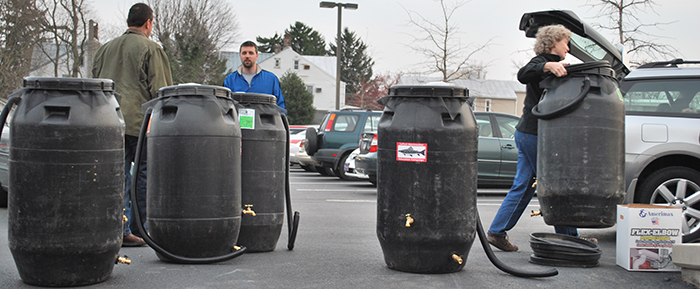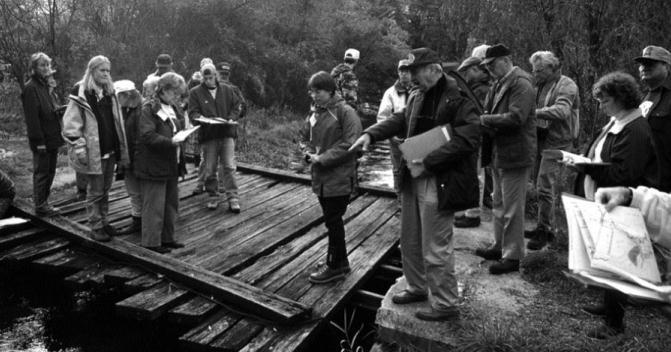
ALLARM was founded in 1986 by Dickinson College Professor Candie Wilderman, as the Alliance for Acid Rain Monitoring. The original focus of ALLARM's mission was to study the impact of acid deposition on Pennsylvania's waterways and the effectiveness of the Clean Air Act amendments, which was achieved with the help of community volunteers across Pennsylvania. With more than 500 volunteers monitoring sites statewide, this initiative eventually resulted in the most comprehensive database of pH and alkalinity of Pennsylvania streams.
In 1996, ALLARM expanded its focus and changed its mission - ALLARM began working with communities on a broader range of water resource concerns in addition to the issue of acid deposition. Furthermore, ALLARM took on a service provider role by offering assistance to watershed groups to build their ability to conduct science and address community concerns about their local water resources.
While we work on updating this page with ALLARM's most recent endeavors, please refer to this document: About ALLARM
Past Projects
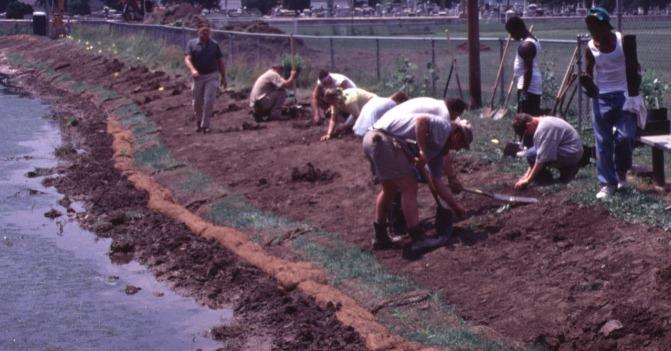
pH Database - Acid Rain Monitoring
In 1986, the state legislature in the Carlisle area was working on passing an Acid Deposition Control Act due to the prevalence of acid rain within the state. The acidic nature of the rain was due to the number of cities in the northeast, paired with the prevalence of coal in the region (primarily Pennsylvania and Ohio). The legislator found that, because his constituents didn’t know anything about acid rain, they didn’t care to solve the problem. To combat this, he called on a group of scientists, which included Dr. Candie Wilderman, to help foster this care by informing the public. His hope was to have these scientists, paired with constituents, to go out to streams so that they could monitor and see the results of acid rain in real time - unfortunately, this plan didn’t come to fruition as intended. There were concerns about sending people without training to a stream as the data collected would have no “validity.”
Despite the plan no longer being in place, Candie took a step back and figured that even if the data wasn’t at laboratory standard, it would still be a great experience for her students. She talked with others around the state, researched protocols, and started the seed of a project of monitoring streams for the effects of acid rain deposition.
Through a publication in The Angler about the project titled “Why be ALLARMed?,” Candie made a call-out for people to join them in studying the effects of acid rain - this went to tens of thousands of people and Candie started to receive call upon call of people interested in getting involved.
This interest in involvement allowed for ALLARM to be created and to hire students on campus to handle the capacity of those interested in helping monitor. Data started to pour in, and these data were not only good for educational purposes, these data were collected weekly and pH and alkalinity patterns began to arise. It showed that previous hypotheses were grossly underestimating the problem. Thanks to amendments to the clean air act in 1990, the sources that were causing acid rain were capped.
Over the span of this project, monitoring occurred at 550 sites in 96% of Pennsylvania's counties and it became the largest database of pH and alkalinity in the state. After more than 10 years and more than 16,000 volunteer hours, this effort resulted in the most comprehensive database of pH and alkalinity in Pennsylvania streams.
This database, updated in 2004, is available online on the Pennsylvania Spatial Data Access (PASDA) site.
Mully Grub
The Mully Grub stream runs through the Borough of Carlisle, and is a tributary of the LeTort Spring Run, a renowned trout stream. The source spring of the Mully Grub is buried under Carlisle. As Carlisle developed over the centuries, the Mully Grub was redirected through underground piping. Today, most of the Mully Grub flows beneath the streets, a small section rises above ground near the confluence with the LeTort Spring Run.
In 1998, after years of monitoring and collecting stream data, Candie Wilderman and her students demonstrated that the Mully Grub contributed pollution to the LeTort. As a result of these findings the LeTort Regional Authority, a community watershed organization, worked with ALLARM and Dickinson students to develop a restoration plan. The project is an excellent example of what can be accomplished through the cooperation of a community and an academic institution. The full case study, completed in 2004, can be viewed here.
Stream Restoration at the College Farm
Starting in 2012, ALLARM Stream Restoration Coordinators, in collaboration with the Dickinson College Farm, began researching and developing protocols for the stream restoration project. Known as a riparian buffer, or protective area of vegetation next to a body of water, this project was built along the Yellow Breeches Stream near the Dickinson College Farm. Riparian buffers are valuable tools for ensuring good stream quality and have multiple functions: to stabilize stream banks, provide shade and mitigate the negative effects of nutrient and pollutant stormwater runoff. This project has made the site an accessible educational area for both the College and the greater Carlisle communities, while converting an animal pasture into a buffer to protect the stream against pollution and runoff. Learn about the trees of the buffer.
Phase One
Completed Fall 2013 - Phase One will stabilize the stream bank with trees and shrubs native to the area with large root systems to filter surface runoff and remove nutrients in groundwater, reducing the impacts of flooding and acting as a natural floodplain. The site was first prepared through the removal of invasive vegetation over the summer with the help of over 40 volunteers. In the fall, Stream Restoration Coordinators and volunteers planted the native trees in the buffer zone.
Phase Two
Completed Fall 2014 - Around 30 volunteers worked with Watershed Coordinators to plant and mulch 185 trees in this zone. Similar to Phase One, Phase Two trees are native with large root systems to protect against flooding, however native fruit bearing trees were also selected for this zone. A 30 by 30 foot area was left cleared in this zone to be used as an educational for visitors to interact with and learn about the stream restoration project.
Phase Three
Completed Spring 2015 - 150 native trees and shrubs were planted and mulched with the help of volunteers and Watershed Coordinators. Major goals included using vegetation to alter the flow of stormwater runoff, reduce erosion, filter out sediments and chemicals and allow runoff to seep into the ground further from to the stream. Maintenance is to be done as years follow - growth is being monitored, and trees that have been planted are re-stabilized and mulched as needed.
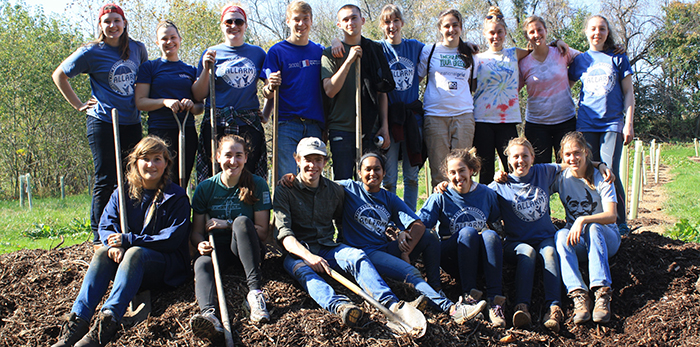
Shale Gas Monitoring
Starting in 2010, over 1,000 unconventional wells were drilled into Pennsylvania every year. In response to community concern and call for assistance, ALLARM developed developed a volunteer monitoring program for communities interested in assessing small streams and their watersheds for early detection of impacts from shale gas extraction activities. Over the course of the monitoring, ALLARM held over 60 volunteer workshops, and trained over 2,000 volunteers in Pennsylvania, New York and West Virginia to monitor water quality using chemical, stage and visual assessments thanks to funding provided by the Consortium for Scientific Assistance to Watersheds (C-SAW) and the Colcom Foundation.
Stormwater and Stormwater Education
Stormwater pollution is one of the leading sources of non-point pollution causing stream health degradation in Pennsylvania and in the nation. Our local stream in Carlisle, the LeTort Spring Run, is no exception. Stormwater in Carlisle comes from storm drains across town, concentrating untreated discharge into the Mully Grub Stream and LeTort Spring Run.
In 2007, ALLARM commenced a partnership with the Borough of Carlisle to collaboratively achieve the public education and public participation requirements of the Borough's Municipal Separate Storm Sewer System (MS4) permit. This partnership has resulted in a dynamic campaign that has grown to include Cumberland Valley Trout Unlimited and LeTort Regional Authority. The program's goals are to educate the Carlisle community about stormwater runoff and its effects on the LeTort Spring Run, and promote stream-conscious behaviors and healthy stream habits. To achieve our goals ALLARM designs and disseminates educational materials as well as engages in several community-based volunteer opportunities focusing on stormwater education.
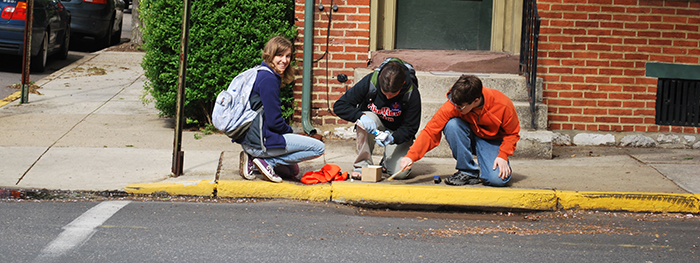
Dickinson College Stormwater Best Management Practices (BMP) Story Map - Karan Shakya '20
Adopt A Storm Drain
The Adopt a Storm Drain campaign engaged volunteers to help minimize street flooding and pollution runoff into the LeTort by helping to keep storm drains clear of trash, leaves, and debris. Volunteers are responsible for attending to their adopted storm drain once a week and making sure it is clear of any debris that might be blocking it. ALLARM and the Borough of Carlisle also worked together to place storm drain markers on the curbs at storm drains throughout the town. The markers read “Don’t Dump, Drains to LeTort”, reminding passersby that all materials that enter through the drain will go directly into the LeTort. ALLARM has worked with local high schools as well as boy scouts to lay down as many markers as possible.
Rain Barrel Workshops
As a part of the effort to reduce the amount of stormwater, ALLARM hosted workshops educating residents of the Borough about the use of rain barrels and provides barrels to attendees. The barrels are great tools for capturing rain water for future use in gardens, washing cars, etc. These workshops, while often smelling lightly of pickles (from the barrels used) were a great way to connect with the community and to educate the public on uses of stormwater.
